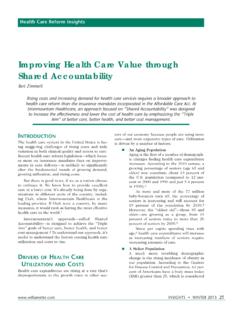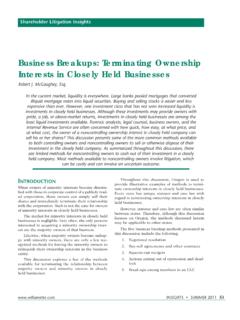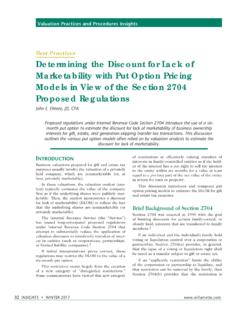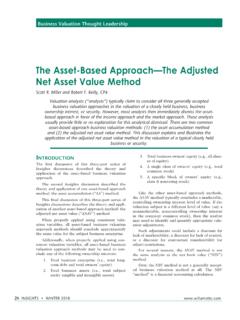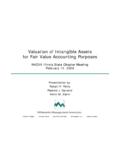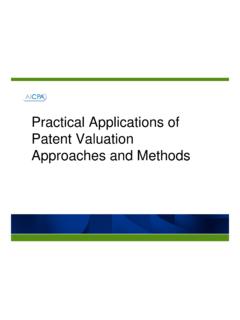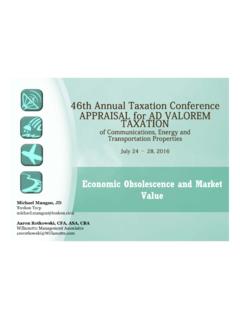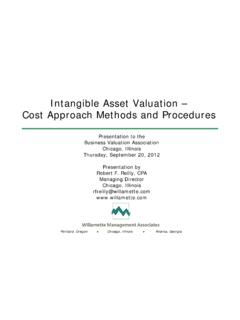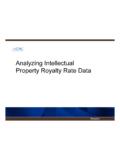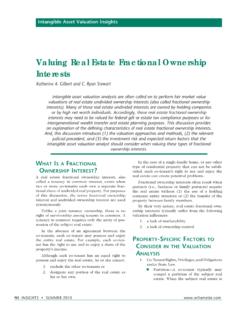Transcription of The Often Overlooked Income Tax Rules of Life Insurance ...
1 42 insights AUTUMN 2013 www .willamette .comThe Often Overlooked Income Tax Rules of Life Insurance PoliciesDonald O. Jansen, Esq., and Lawrence Brody, Planning and Compliance InsightsLife Insurance is a unique product that provides needed liquidity during the lifetime and at the death of the insured. It is useful in business and estate planning and can be a wealth creation or wealth transfer vehicle. The taxation of life Insurance proceeds is complex and subject to certain exemptions. It is important to be familiar with the particular life Insurance Rules in order to avoid unexpected Income tax consequences. This discussion summarizes some of the unique Income tax attributes associated with life Insurance policies and the tax planning strategies that involve life , death proceeds and cash value build-up in the life Insurance policy are free from fed-eral Income taxes.
2 But this is not always the case. There are several exceptions to the Income -tax-free receipt of death proceeds, including the following:1. Transfers of the policy during the insured s lifetime for value2. The receipt of the death proceeds of some employer-owned life insuranceThe otherwise tax-free build-up of life Insurance value may be subject to Income tax if:1. the cash value is accessed and the policy is a modified endowment contract;2. the policy is surrendered, lapses, or sold; or3. there are significant dividends or policy withdrawals or policy discussion relies on certain guidance and definitions presented in the Internal Revenue Code and Regulations.
3 Where applicable, this discussion aggregates some of the more relevant definitions found in the Code and Regulations and presents that information on Exhibit oF liFE Insurance dEath bEnEF itsAssuming that a policy meets the applicable defi-nition of life Insurance , the general rule is that any proceeds paid by reason of the death of the insured are not included in the beneficiary s tax-able rule applies to the entire death proceeds, but it does not apply to interest paid by the insur-ance carrier on the proceeds after the insured s death. Any such interest is includible in the ben-eficiary s taxable Income .
4 In the case of proceeds paid in installments, a portion of each payment represents nontaxable proceeds and the balance is taxable Income to the beneficiary. The manner of the allocation depends on the type of installment payment are several exceptions to the general rule that death proceeds are excluded from taxable Income . The most notable exception among these is the so-called transfer for value rule of Internal Revenue Code Section 101(a)(2). This rule is trig-gered when the policy (or even an interest in the policy) has been transferred during the insured s lifetime (other than as a pledge or assignment as security) for a valuable consideration (whether or not in a sale transaction).
5 Www .willamette .com insights AUTUMN 2013 43 Another exception is the employer-owned life Insurance rule. This exception potentially includes death proceeds received by employers on the lives of certain employees in the employer s transfer for value rule and the employer owned Insurance rule are summarized for Value RuleWhen there has been a transfer of the policy for value during the insured s lifetime, the proceeds paid by reason of the insured s death will be includ-able in the beneficiary s taxable Income . This is true to the extent that the proceeds exceed the sum of (1) the consideration paid for the transfer and (2) the premiums paid by the buyer subsequent to the to the Transfer For Value RuleThere are, however, helpful exceptions to the trans-fer for value rule (which in some ways have become the rule).
6 The transfer for value rule does not apply ( , the proceeds are not taxed) when a policy is transferred for a valuable consideration to the fol-lowing parties:1. The insured2. A partner of the insured3. A partnership in which the insured is a partner (including an LLC taxed as a part-nership in which the insured is a member)4. A corporation in which the insured is a shareholder or officer (the proper party exception).2 There are other instances where the transfer for value rule does not , the transfer for value rule does not apply if the transferee s basis in the policy is determined in whole or in part by reference to the transferor s basis in the policy.
7 This is known as the carryover basis , if a policy is acquired by gift, the trans-fer for value rule generally does not apply. This is because the transferee s basis will be the same as the transferor s basis under Section 1014. The same rule would apply if a policy is contributed to a partner-ship or a corporation, so long as the contribution was , transfers between spouses (or former spouses, if the transfer is incident to a divorce) that occurred after July 18, 1984, are treated as , under Revenue Ruling 2007-13,5 a trans-fer for value (a sale) of a policy by the insured grantor (or even by another grantor trust created by the insured) to a grantor trust from the insured s point of view will be treated as an exempt transfer to the insured for this purpose.
8 This transfer would also qualify for another exception to the transfer for value rule. This is because the sale would be ignored for Income tax purposes and the transfer would therefore qualify as a carryover basis transaction, under Revenue Ruling a policy is transferred by gift, the Income -tax-free death proceeds are limited to the sum of:1. the amount that would have been exclud-ible by the party making the transfer had no transfer taken place plus2. any premiums and other amounts paid after the transfer by the either case, however, where the transfer is made to one of the proper party individuals or entities described in Section 101(a)(2)(B), the entire amount of the proceeds will be excludible from the transferee s gross are also complex Rules for determining which, if any, exception applies in a series of trans-fers of a Transfer RuleWhat if the last transfer prior to the insured s death was by gift, but there were other transfers prior to that for value?
9 As noted above, the answer is that the taint remains, unless the final transfer is to one of the safe harbor exempt parties, which would remove it. For example, where the last owner s basis is deter-mined in whole or in part by reference to the prior owner s basis, the Income tax exclusion is limited to the sum of:1. the amount that the transferor could have excluded had no transfer taken place and2. any premiums or other amounts paid by the final effect of a series of transfers for a valuable consideration of a life Insurance policy or an inter-est therein is addressed in Regulation (b)(3)(ii). This regulation indicates that if the final trans-fer is to the insured, to a partner of the insured, to a partnership in which the insured is a partner, or to a corporation in which the insured is a shareholder or officer, then the final transferee can exclude the entire amount of the life Insurance policy proceeds paid by reason of death of the insured from gross Income under Section 101(a)(1).
10 44 insights AUTUMN 2013 www .willamette .comIf the last transfer is for valuable consideration, then only the actual consideration paid by that transferee (plus premiums or other amounts paid after the transfer) is the last transfer is a gift (or part sale and part gift, with more gift than sale), where the donee s basis is determined at least in part by reference to the donor s basis (which, as noted above, is not always the case in a part sale/part gift situation), then the final transferee will be able to exclude the entire amount of the the last transfer is to one of the five proper parties, then that exempt transferee will be able to exclude the entire amount of the proceeds from gross the last transferor rule be avoided by washing an otherwise tainted transaction through a brief ownership by the insured?

